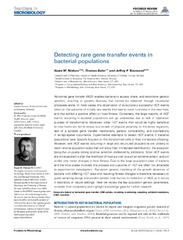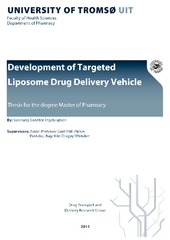Institutt for farmasi: Recent submissions
Now showing items 541-560 of 706
-
Detecting rare gene transfer events in bacterial populations
(Journal article; Tidsskriftartikkel; Peer reviewed, 2014) -
Humoral and cellular immune responses in mice after airway administration of Bacillus thuringiensis Cry1Ab and MON810 cry1Ab-transgenic maize
(Journal article; Tidsskriftartikkel; Peer reviewed, 2014)Genetically modified (GM) crops may bring new proteins with immunogenic and allergenic properties into the food and feed chains. The most commonly grown GM maize, MON810, expresses a modified version of the insecticidal Cry1Ab protein originating in the soil bacterium Bacillus thuringiensis(Bt). Immune reactions following inhalation of pollen and debris from such plants have been scarcely studied. ... -
Phospholipid Vesicle-Based Permeation Assay and EpiSkin in Assessment of Drug Therapies Destined for Skin Administration
(Journal article; Tidsskriftartikkel; Peer reviewed, 2014) -
Elastic liposomes-in-vehicle formulations destined for skin therapy: the synergy between type of liposomes and vehicle
(Journal article; Tidsskriftartikkel; Peer reviewed, 2014-07-14) -
Liposomes for (trans)dermal drug delivery: the skin-PVPA as a novel in vitro stratum corneum model in formulation development
(Journal article; Tidsskriftartikkel; Peer reviewed, 2014-03-19)Penetration potential of vesicles destined for trans(dermal) administration remains to be of great interests both in respect to drug therapy and cosmetic treatment. This study investigated the applicability of the phospholipid vesicle-based permeation assay (PVPA) as a novel in vitro skin barrier model for screening purposes in preformulation studies. Various classes of liposomes containing hydrophilic ... -
Chitosan-coated liposomes for topical vaginal therapy: Assuring localized drug effect
(Journal article; Tidsskriftartikkel; Peer reviewed, 2014)The choice of drug therapy in pregnant patients suffering from vaginal infections is limited by the safety profile of the drug. Assuring the efficient topical therapy to avoid systemic absorption is considered the best therapy option. Chitosan-coated liposomes have been developed and optimized to assure localized therapy of clotrimazole. Chitosan was selected as mucoadhesive polymer both to prolong ... -
Improved Permeability of Acyclovir: Optimization of Mucoadhesive Liposomes Using the Phospholipid Vesicle-Based Permeation Assay
(Journal article; Tidsskriftartikkel; Peer reviewed, 2014-01-06) -
Bioadhesive Mini-Tablets for Vaginal Drug Delivery
(Journal article; Tidsskriftartikkel; Peer reviewed, 2014-08-27) -
Chitosan in Mucoadhesive Drug Delivery: Focus on Local Vaginal Therapy
(Journal article; Tidsskriftartikkel; Peer reviewed, 2015-01-07)Mucoadhesive drug therapy destined for localized drug treatment is gaining increasing importance in today’s drug development. Chitosan, due to its known biodegradability, bioadhesiveness and excellent safety profile offers means to improve mucosal drug therapy. We have used chitosan as mucoadhesive polymer to develop liposomes able to ensure prolonged residence time at vaginal site. Two types of ... -
Antibiotikaresistens - kunnskapshull, utfordringer og aktuelle tiltak. Rapport fra tverrsektoriell ekspertgruppe
(Research report; Forskningsrapport, 2014) -
Molecular characterization and phylogenetics of Fennoscandian cowpox virus isolates based on the p4c and atip genes
(Journal article; Tidsskriftartikkel; Peer reviewed, 2014)Background: Cowpox virus (CPXV), a rodent-borne Orthopoxvirus (OPV) that is indigenous to Eurasia can infect humans, cattle, felidae and other animals. Molecular characterization of CPXVs isolated from different geographic locations is important for the understanding of their biology, geographic distribution, classification and evolution. Our aim was to characterize CPXVs isolated from Fennoscandia ... -
Development of targeted liposome drug delivery vehicle
(Master thesis; Mastergradsoppgave, 2012-05-20)Coating of liposomes with polyethylene glycol (PEG) has proven to prolong the circulation time of liposomes in the blood stream. PEG prevents the binding of opsonins and subsequent uptake of the liposomes by mononuclear phagocytic system (MPS). The reduction in clearance of PEGylated liposomes from the circulation improve the bioavailability of the liposomes in the blood and increase the chance of ... -
Liposomes as drug delivery system in mitochondrial targeting
(Master thesis; Mastergradsoppgave, 2012-05-20)The mitochondrion is a subcellular organelle with major functions related to energy production and control of apoptosis. The presence of mitochondria as a subcellular organelle has been known for more than one and a half century. However, only the last decades’ research has discovered their role in ageing and disease pathology, which have led to increasing interest in mitochondria as target for drug ... -
Risk assessment of GM trees in the EU: current regulatory framework and guidance
(Journal article; Tidsskriftartikkel; Peer reviewed, 2013)The use of genetically modified organisms - their release into the environment, import, and utilisation as food/feed or food/feed ingredients - is regulated in the European Union (EU). For placing onto the market, current legislations require a comprehensive and science-based risk assessment. This risk assessment (RA) is performed by applicants and then evaluated by national authorities in close ... -
Liposomes-in-Hydrogel Delivery System with Mupirocin: In Vitro Antibiofilm Studies and In Vivo Evaluation in Mice Burn Model
(Journal article; Tidsskriftartikkel; Peer reviewed, 2013)Previously, we have proposed mupirocin-in-liposomes-in-hydrogel delivery system as advanced delivery system with the potential in treatment of burns. In the current studies, we evaluated the system for its cytotoxicity, ability to prevent biofilm formation, act on the mature biofilms, and finally determined its potential as wound treatment in in vivo mice burn model.The system was found to be ... -
Clone- and age-dependent toxicity of a glyphosate commercial formulation and its active ingredient in Daphnia magna.
(Journal article; Tidsskriftartikkel; Peer reviewed, 2013)Low levels of glyphosate based herbicide induced significant negative effects on the aquatic invertebrate Daphnia magna. Glyphosate herbicides such as brands of Roundup, are known to be toxic to daphnids. However, published findings on acute toxicity show significant discrepancies and variation across several orders of magnitude. To test the acute effects of both glyphosate and a commercial ... -
Osteopontin is a prognostic biomarker in non-small cell lung cancer
(Journal article; Tidsskriftartikkel; Peer reviewed, 2013)Background: In a previously published report we characterized the expression of the metastasis-associated proteins S100A4, osteopontin (OPN) and ephrin-A1 in a prospectively collected panel of non-small cell lung cancer (NSCLC) tumors. The aim of the present follow-up study was to investigate the prognostic impact of these potential biomarkers in the same patient cohort. In addition, circulating ... -
Metabolic biomarkers for response to PI3K inhibition in basal-like breast cancer
(Journal article; Tidsskriftartikkel; Peer reviewed, 2013)Introduction: The phosphatidylinositol 3-kinase (PI3K) pathway is frequently activated in cancer cells through numerous mutations and epigenetic changes. The recent development of inhibitors targeting different components of the PI3K pathway may represent a valuable treatment alternative. However, predicting efficacy of these drugs is challenging, and methods for therapy monitoring are needed. ... -
Characterization of extracellular polymeric matrix, and treatment of Fusobacterium nucleatum and Porphyromonas gingivalis biofilms with DNase I and proteinase K
(Journal article; Tidsskriftartikkel; Peer reviewed, 2013)Background: Biofilms are organized communities of microorganisms embedded in a self-produced extracellular polymeric matrix (EPM), often with great phylogenetic variety. Bacteria in the subgingival biofilm are key factors that cause periodontal diseases; among these are the Gram-negative bacteria Fusobacterium nucleatum and Porphyromonas gingivalis. The objectives of this study were to characterize ... -
Identical Miniature Inverted Repeat Transposable Elements Flank Class 1 Integrons in Clinical Isolates of Acinetobacter spp.
(Journal article; Tidsskriftartikkel; Peer reviewed, 2013)Miniature inverted repeat transposable elements (MITEs) have been identified flanking class 1 integrons. We have identified and characterized a 439-bp MITE-like structure in seven Acinetobacter species isolates from Portugal and Brazil. The complete sequence similarity of the elements and flanking regions suggests that MITEs may act as mobilizable vectors for the dissemination of integrons.


 English
English norsk
norsk


















